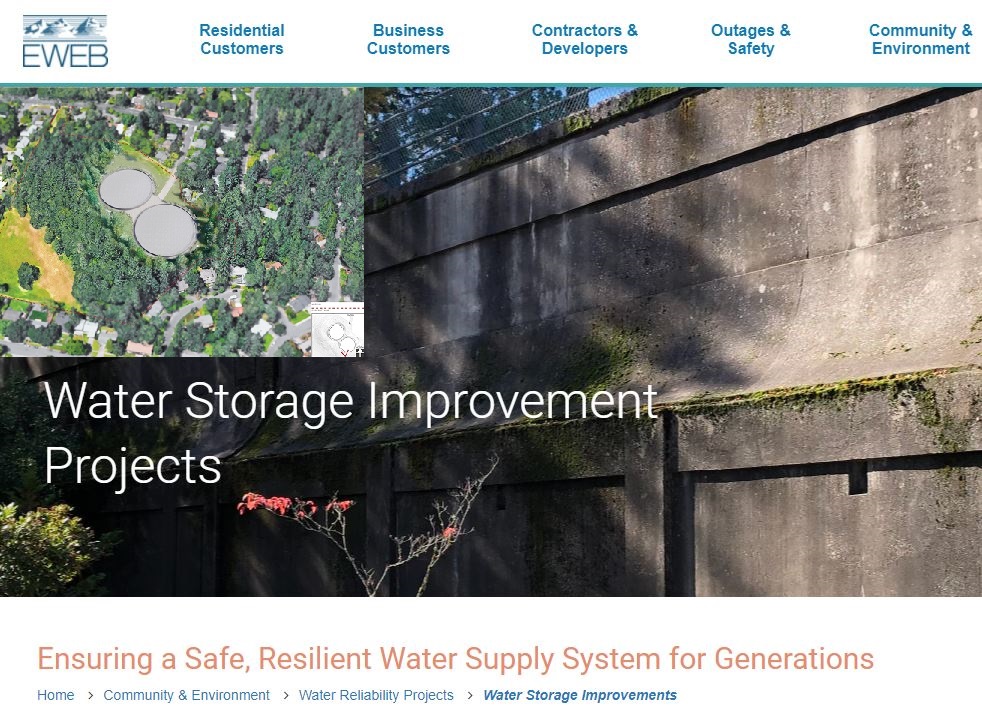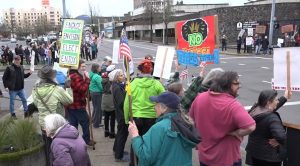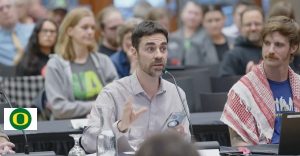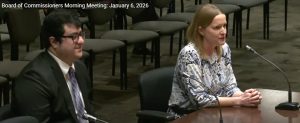Neighbors, board member question EWEB last-minute switch
7 min read
EWEB made a last-minute switch and now will construct two Patterson Hill water tanks at the same time.
John Barofsky: I just want to make sure that we don’t have this type of last-minute switch again because I think it loses trust with the community that I represent.
John Q: [00:00:11] Commissioner John Barofsky, speaking on EWEB’s water storage project. Construction starts August 2, as EWEB builds both water storage tanks planned atop Patterson Hill, above East 40th. Board president Mindy Schlossberg introduced the topic at the board’s April 2021 meeting.
Mindy Schlossberg: [00:00:33] We can go on to agenda item number seven, Record of Decision, the final design report for the East 40th water storage project.
Frank Lawson: [00:00:41] Great. President Schlossberg, Commissioners, good evening.
John Q: [00:00:44] General Manager Frank Lawson.
Thank you for supporting
local citizen journalism
Frank Lawson: [00:00:46] Pertaining to this topic, you did receive a pretty robust, 167-page background package, the decision to construct both tanks concurrently beginning in 2021.
In our analysis, there are significant economic, social and environmental reasons for the siting and concurrent construction of both tanks. It does provide greater flexibility. When we look at the sequencing with the other work that we want to do at College Hill, and at Hawkins, which are both projects that will still be upgraded, and potentially also a storage site at the new water treatment plant in Glenwood, so it does provide additional flexibility.
The independent, triple bottom line analysis showed that it requires the least amount of rock excavation, impacts to the view shed for the fewest number of adjacent neighbors, it preserves the ridgeline, and protects the largest amount of the oak habitat, which is also listed by the state of Oregon as a strategic habitat.
John Q: [00:01:52] By building both tanks now, he said we can save over a million dollars and about two thousand truck trips.
Frank Lawson: [00:02:01] I’d like to thank our Chief Operating Officer Rod Price, our Water Division Manager Karen Kelley, our Project Manager Laura Farthing, Communication Supervisor Jen Connors, and also our Customer Relationship Manager Jeannine Parisi for their work so far on the project. I’m really pleased with how the project’s been managed, the detail with which they’ve provided information to management and the board and the public and expect and acknowledge that this project will have significant impacts on the neighborhood for a period of time. It will be shorter if done and procured and mobilized once as opposed to twice. I do believe that if we did it twice, people would look back 10 years from now and say, Why didn’t you just do this all at once? Especially given that Hilyard will be resurfaced during that time.
John Q: [00:02:52] A nearby neighbor wondered why the Southeast neighborhood was being punished.
Stephen Anderson: [00:02:57] I’m Stephen Anderson. I live on Hilyard in Ward Two right next to the project here on Patterson Hill, which was named by my deceased neighbor who lived here when there was only one house on it.
From our point of view, EWEB is again losing credibility. Instead of getting better as we communicate, it’s worse. We need answers. For example, why have years of planning for one tank now, and one in the future, suddenly become two tanks immediately, impacting this neighborhood and all of south Eugene for at least three years. Although engineering friends tell us it will be closer to four. What in the world is going on?
It feels as if we who had the temerity to question the location of the tanks are now being punished for caring about the environment and the neighborhood. From day one, we were told you were already in a hurry, anxious about earthquake effects on the current system. And now you’re not in a hurry at all. It can take three or four years, and then we’ll have two tanks.
We were told that initially the long-term plan was a new tank there on College Hill after our first tank was completed. And then you could easily build a second tank there on the decommissioned tank site once your wi-fi power contract is up. So long before you need Tank Two on Patterson Hill, you could be building down there, which is much closer to the freeway and would impact far fewer citizens with truck traffic because of easy access to the freeway. So why are current taxpayers being asked to pay for extra storage now, here, rather than 10 years from now?
If this is so important, why wasn’t it part of your many years of planning? Now you’re changing horses in midstream. Your engineering firm on page one of their report to what you just sent us this week finally sited Tank One exactly where we’ve asked it to be all this time, which is in the middle of the site, which would save our big trees as long as possible. It would be very easy to move that tank 30 feet north, and then it would not impact drilling or blasting for Tank Two is a decade down the road. When we visited with your engineer at the EWEB tent meeting, that’s exactly what he told us.
And lastly, there’s not a single member of the EWEB board or staff that would want Tank One sited within 60 feet of their property line on a property this big. Yet that’s exactly what you’re planning and the justification: You need to keep the ridgeline view pristine. What in the world are you talking about? People directly below the ridge can’t even see a tank if it’s moved 30 feet west. And the view of the ridge is from the playground or people up on other hills and a screen of shrubs or trees would take care of that, don’t you think?
Decide to file a lawsuit, we might be able to find out exactly what’s been going on behind closed doors, call in our own experts , shed some light on what’s really going on. And perhaps then the EWEB board of commissioners will look at this and enjoin the discussion.
John Q: [00:06:03] Sandra Bishop.
Sandra Bishop: [00:06:04] What does this mean for the neighborhood? Building two tanks now will extend the construction period for two or three years. There’ll be more than twice the number of trees cut to make room for the second tank. The impact to neighborhood streets and safety will be profound.
To build two tanks now, there’d be thousands more ton of rock blasted and hauled off the site. Putting all those trucks past Tugman Parks for additional years at the time. Who will pay for this excess capacity? The rate payers. And how does this fit with the citywide storage plan?
Does this means College Hill tanks are not going to be recommissioned or reconstructed on time. What about the Hawkins Heights? What about West Eugene? This decision will probably put this project over budget and off schedule. This will add millions to the cost. A Record of Decision is a very convoluted, backward way to make such a decision that is going to cost this much.
What about Santa Clara? What about these other projects? Why burden taxpayers now for something in the future? So please. Look at the equity of this. Why are you building excess capacity in well-to-do neighborhoods. Please get back to the original plan. The well thought up planning to build this system throughout the city. Please look at the social and economic and environmental equity with this.
John Q: [00:07:40] Commissioner John Barofsky.
John Barofsky: [00:07:42] The problem that I’m having is the switch from one tank to two tanks and the public process that went into that. Even in those early months, it was: one tank, College Hill, Hawkins, another tank. And that’s what has been presented to the neighbors. If we had gone in with the public process and said, we’re building two tanks here and we want to hear from the public, the two-tank option came along fairly quickly in my view. As one of the people said earlier, if we’re going to change horses in midstream, we need to look at that because I don’t think that’s the proper way to do it. I’m sorry that it wasn’t presented in this way all along for the last year and a half to two years, because I think what that does is it loses trust with the community that I represent.
The one thing that I was very encouraged by was that my predecessor, Dick Helgeson, weighed in on public testimony and gave his evaluation that this was probably the correct way to go. And as somebody who has as much experience as he has, that gives me a lot confidence in moving forward with the way we’re going.
I just want to make sure that moving forward that we don’t have this type of last-minute switch again, because these are very impactful decisions that we’re making and we need to make them carefully. And I think we did, and I think it was well thought out, but I think that we can learn from this going forward.
John Q: [00:09:22] For the latest on the East 40th Project, see eweb.org.






